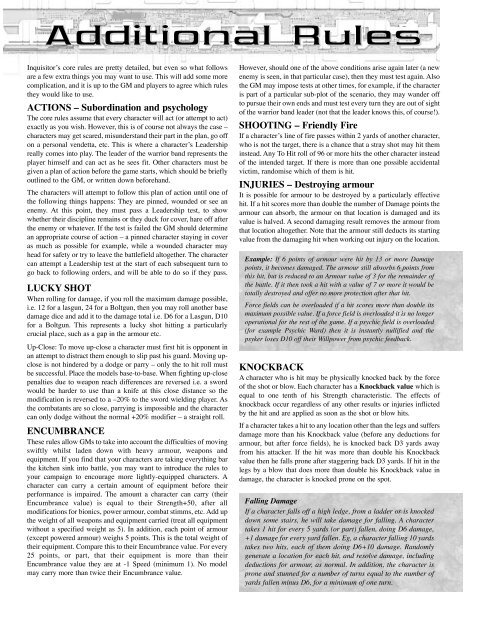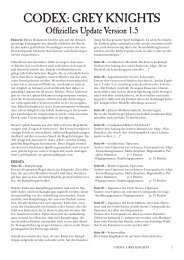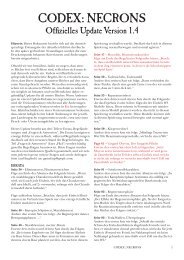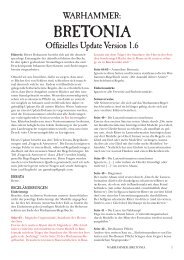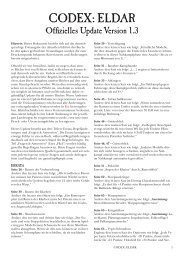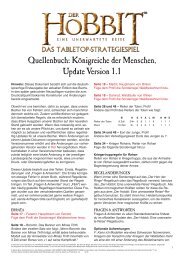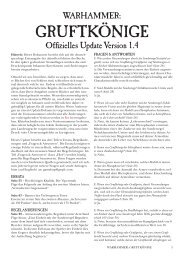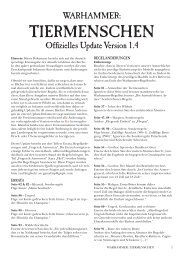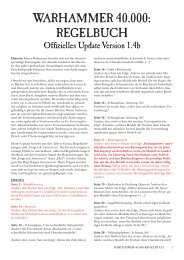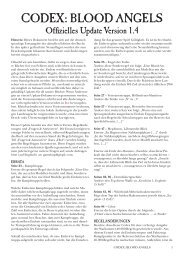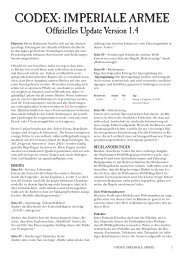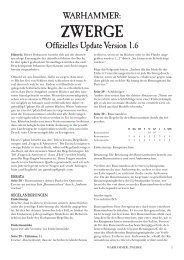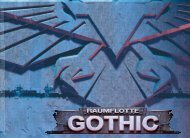Warhammer 40k - Inquisitor - The Living Rule Book 1.1 (Part II).
Warhammer 40k - Inquisitor - The Living Rule Book 1.1 (Part II).
Warhammer 40k - Inquisitor - The Living Rule Book 1.1 (Part II).
You also want an ePaper? Increase the reach of your titles
YUMPU automatically turns print PDFs into web optimized ePapers that Google loves.
Additional <strong>Rule</strong>s<br />
<strong>Inquisitor</strong>’s core rules are pretty detailed, but even so what follows<br />
are a few extra things you may want to use. This will add some more<br />
complication, and it is up to the GM and players to agree which rules<br />
they would like to use.<br />
ACTIONS – Subordination and psychology<br />
<strong>The</strong> core rules assume that every character will act (or attempt to act)<br />
exactly as you wish. However, this is of course not always the case –<br />
characters may get scared, misunderstand their part in the plan, go off<br />
on a personal vendetta, etc. This is where a character’s Leadership<br />
really comes into play. <strong>The</strong> leader of the warrior band represents the<br />
player himself and can act as he sees fit. Other characters must be<br />
given a plan of action before the game starts, which should be briefly<br />
outlined to the GM, or written down beforehand.<br />
<strong>The</strong> characters will attempt to follow this plan of action until one of<br />
the following things happens: <strong>The</strong>y are pinned, wounded or see an<br />
enemy. At this point, they must pass a Leadership test, to show<br />
whether their discipline remains or they duck for cover, hare off after<br />
the enemy or whatever. If the test is failed the GM should determine<br />
an appropriate course of action – a pinned character staying in cover<br />
as much as possible for example, while a wounded character may<br />
head for safety or try to leave the battlefield altogether. <strong>The</strong> character<br />
can attempt a Leadership test at the start of each subsequent turn to<br />
go back to following orders, and will be able to do so if they pass.<br />
LUCKY SHOT<br />
When rolling for damage, if you roll the maximum damage possible,<br />
i.e. 12 for a lasgun, 24 for a Boltgun, then you may roll another base<br />
damage dice and add it to the damage total i.e. D6 for a Lasgun, D10<br />
for a Boltgun. This represents a lucky shot hitting a particularly<br />
crucial place, such as a gap in the armour etc.<br />
Up-Close: To move up-close a character must first hit is opponent in<br />
an attempt to distract them enough to slip past his guard. Moving upclose<br />
is not hindered by a dodge or parry – only the to hit roll must<br />
be successful. Place the models base-to-base. When fighting up-close<br />
penalties due to weapon reach differences are reversed i.e. a sword<br />
would be harder to use than a knife at this close distance so the<br />
modification is reversed to a –20% to the sword wielding player. As<br />
the combatants are so close, parrying is impossible and the character<br />
can only dodge without the normal +20% modifier – a straight roll.<br />
ENCUMBRANCE<br />
<strong>The</strong>se rules allow GMs to take into account the difficulties of moving<br />
swiftly whilst laden down with heavy armour, weapons and<br />
equipment. If you find that your characters are taking everything bar<br />
the kitchen sink into battle, you may want to introduce the rules to<br />
your campaign to encourage more lightly-equipped characters. A<br />
character can carry a certain amount of equipment before their<br />
performance is impaired. <strong>The</strong> amount a character can carry (their<br />
Encumbrance value) is equal to their Strength+50, after all<br />
modifications for bionics, power armour, combat stimms, etc. Add up<br />
the weight of all weapons and equipment carried (treat all equipment<br />
without a specified weight as 5). In addition, each point of armour<br />
(except powered armour) weighs 5 points. This is the total weight of<br />
their equipment. Compare this to their Encumbrance value. For every<br />
25 points, or part, that their equipment is more than their<br />
Encumbrance value they are at -1 Speed (minimum 1). No model<br />
may carry more than twice their Encumbrance value.<br />
However, should one of the above conditions arise again later (a new<br />
enemy is seen, in that particular case), then they must test again. Also<br />
the GM may impose tests at other times, for example, if the character<br />
is part of a particular sub-plot of the scenario, they may wander off<br />
to pursue their own ends and must test every turn they are out of sight<br />
of the warrior band leader (not that the leader knows this, of course!).<br />
SHOOTING – Friendly Fire<br />
If a character’s line of fire passes within 2 yards of another character,<br />
who is not the target, there is a chance that a stray shot may hit them<br />
instead. Any To Hit roll of 96 or more hits the other character instead<br />
of the intended target. If there is more than one possible accidental<br />
victim, randomise which of them is hit.<br />
INJURIES – Destroying armour<br />
It is possible for armour to be destroyed by a particularly effective<br />
hit. If a hit scores more than double the number of Damage points the<br />
armour can absorb, the armour on that location is damaged and its<br />
value is halved. A second damaging result removes the armour from<br />
that location altogether. Note that the armour still deducts its starting<br />
value from the damaging hit when working out injury on the location.<br />
Example: If 6 points of armour were hit by 13 or more Damage<br />
points, it becomes damaged. <strong>The</strong> armour still absorbs 6 points from<br />
this hit, but is reduced to an Armour value of 3 for the remainder of<br />
the battle. If it then took a hit with a value of 7 or more it would be<br />
totally destroyed and offer no more protection after that hit.<br />
Force fields can be overloaded if a hit scores more than double its<br />
maximum possible value. If a force field is overloaded it is no longer<br />
operational for the rest of the game. If a psychic field is overloaded<br />
(for example Psychic Ward) then it is instantly nullified and the<br />
psyker loses D10 off their Willpower from psychic feedback.<br />
KNOCKBACK<br />
A character who is hit may be physically knocked back by the force<br />
of the shot or blow. Each character has a Knockback value which is<br />
equal to one tenth of his Strength characteristic. <strong>The</strong> effects of<br />
knockback occur regardless of any other results or injuries inflicted<br />
by the hit and are applied as soon as the shot or blow hits.<br />
If a character takes a hit to any location other than the legs and suffers<br />
damage more than his Knockback value (before any deductions for<br />
armour, but after force fields), he is knocked back D3 yards away<br />
from his attacker. If the hit was more than double his Knockback<br />
value then he falls prone after staggering back D3 yards. If hit in the<br />
legs by a blow that does more than double his Knockback value in<br />
damage, the character is knocked prone on the spot.<br />
Falling Damage<br />
If a character falls off a high ledge, from a ladder or is knocked<br />
down some stairs, he will take damage for falling. A character<br />
takes 1 hit for every 5 yards (or part) fallen, doing D6 damage,<br />
+1 damage for every yard fallen. Eg, a character falling 10 yards<br />
takes two hits, each of them doing D6+10 damage. Randomly<br />
generate a location for each hit, and resolve damage, including<br />
deductions for armour, as normal. In addition, the character is<br />
prone and stunned for a number of turns equal to the number of<br />
yards fallen minus D6, for a minimum of one turn.


